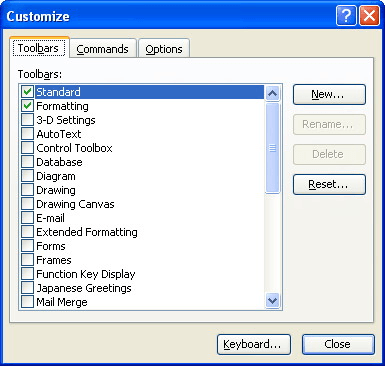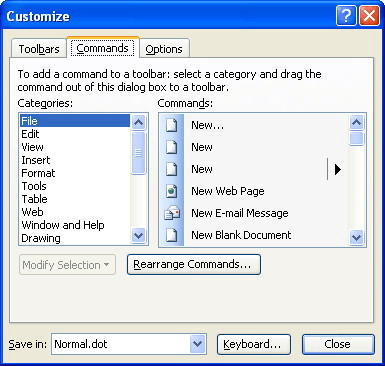Please Note: This article is written for users of the following Microsoft Word versions: 97, 2000, 2002, and 2003. If you are using a later version (Word 2007 or later), this tip may not work for you. For a version of this tip written specifically for later versions of Word, click here: Jumping Back to the TOC.
Written by Allen Wyatt (last updated April 16, 2022)
This tip applies to Word 97, 2000, 2002, and 2003
Len has a rather long document in which he has created a table of contents. If he clicks a link in the TOC, Word displays the heading in the document. If he then wants to return to the TOC, Len notes that there doesn't seem to be a way to easily do so. He wonders if there is a single-click method of returning to the TOC after using the TOC to jump to a location in the document.
There are several different ways that you can approach this problem, and the solution that you choose will depend on your personal preference. One way is to simply rely on the position of your TOC. Most of the time the TOC will be near the very beginning of the document. This fact allows you to press Ctrl+Home to jump to the beginning of the document where the TOC can again be easily accessed.
Many people also choose to use the Document Map capability of Word. Turn it on, and you'll see an outline, at the left of the screen, that makes it easy to navigate through the document. Just locate the heading used for your TOC in the Document Map, click it once, and you are back at the TOC.
Another approach is to use the Go To feature: Just press F5 to display the Go To tab of the Find and Replace dialog box, choose Field at the left side, and then enter "toc" (without the quote marks) at the right side. When you press Enter, Word jumps to the TOC. This works because tables of contents are implemented in Word using fields, specifically the TOC field. Thus, Go To jumps to wherever the TOC field is located.
Still another approach is to use the Shift+F5 shortcut. This keystroke is supposed to cycle through the last three or four locations at which you made edits in your document. In testing, however, it also jumps back to the TOC, even if you didn't make an edit in the TOC. (Why? I'm not sure—it just did it for me.) In other words, you click the hyperlink to the heading, do some reading or work at the heading, then press Shift+F5, and Word jumps back to the TOC. It should be pointed out that this isn't always a reliable method of jumping back; if you make too many edits since you last revisited the TOC, Word will not take you back there.
You can also, if desired, use the Alt+Left Arrow shortcut. This is equivalent to pressing the Back button on your browser—it jumps back to where you were before clicking on the hyperlink in the TOC. This is particularly helpful with the TOC because if the table is quite long, the action will take you back to exactly where you clicked the heading in the TOC, rather than just to the beginning of the table.
If you prefer, you can modify the toolbar to show a Back button. Just follow these steps:

Figure 1. The Toolbars tab of the Customize dialog box.

Figure 2. The Commands tab of the Customize dialog box.
Your new Back command works just the same as the Back button on a browser, and the same as if you pressed the Alt+Left Arrow shortcut.
Word also provides another helpful command you can add to your toolbar. It was created to specifically allow you to jump back to the TOC. The name of the command is "GotoTableOfContents." The command is very convenient, but only works if you have a single TOC in your document. (If, for instance, you have a TOC at the beginning of each section or chapter in your document, then it won't work as expected.) To add it to a toolbar, follow the same steps you used to add the GoBack command, with the only difference being that in step 6 you would locate and select the GotoTableOfContents command.
Some people prefer to use bookmarks to allow jumping back to the TOC. Select something near the beginning of the TOC (perhaps the TOC's header) and bookmark it. Then you can use either Go To to jump to the bookmark, or you can use a small macro to jump back to it:
Sub BackTOC()
Selection.GoTo What:=wdGoToBookmark, Name:="MyTOC"
End Sub
In this case, the name of the bookmark is MyTOC. This macro could be assigned to a keyboard shortcut or it could end up on a toolbar.
You could also create a hyperlink in your document that that jumped back to the bookmark. This hyperlink could easily be placed at the end of each section of your document, or even in the footer of each page.
Note:
WordTips is your source for cost-effective Microsoft Word training. (Microsoft Word is the most popular word processing software in the world.) This tip (884) applies to Microsoft Word 97, 2000, 2002, and 2003. You can find a version of this tip for the ribbon interface of Word (Word 2007 and later) here: Jumping Back to the TOC.

Do More in Less Time! An easy-to-understand guide to the more advanced features available in the Microsoft 365 version of Word. Enhance the quality of your documents and boost productivity in any field with this in-depth resource. Complete your Word-related tasks more efficiently as you unlock lesser-known tools and learn to quickly access the features you need. Check out Microsoft 365 Word For Professionals For Dummies today!
Word makes it easy to create a Table of Contents. If you want column headings in that table, getting them takes a bit of ...
Discover MoreThe TOC (Table of Contents) is generated by a field. This field may be updated in a macro using a single command line.
Discover MoreIt is easy to generate a table of contents for a document, and that TOC can contain page number references for each ...
Discover MoreFREE SERVICE: Get tips like this every week in WordTips, a free productivity newsletter. Enter your address and click "Subscribe."
There are currently no comments for this tip. (Be the first to leave your comment—just use the simple form above!)
Got a version of Word that uses the menu interface (Word 97, Word 2000, Word 2002, or Word 2003)? This site is for you! If you use a later version of Word, visit our WordTips site focusing on the ribbon interface.
Visit the WordTips channel on YouTube
FREE SERVICE: Get tips like this every week in WordTips, a free productivity newsletter. Enter your address and click "Subscribe."
Copyright © 2025 Sharon Parq Associates, Inc.
Comments